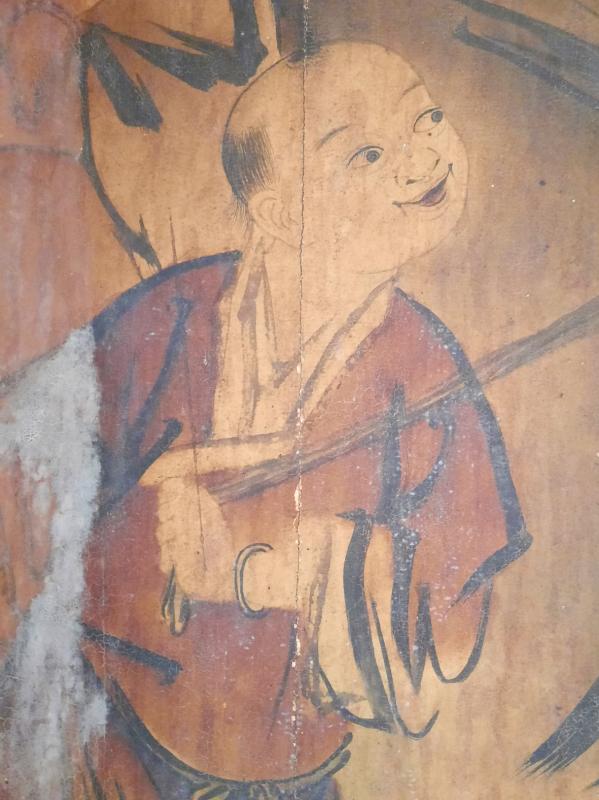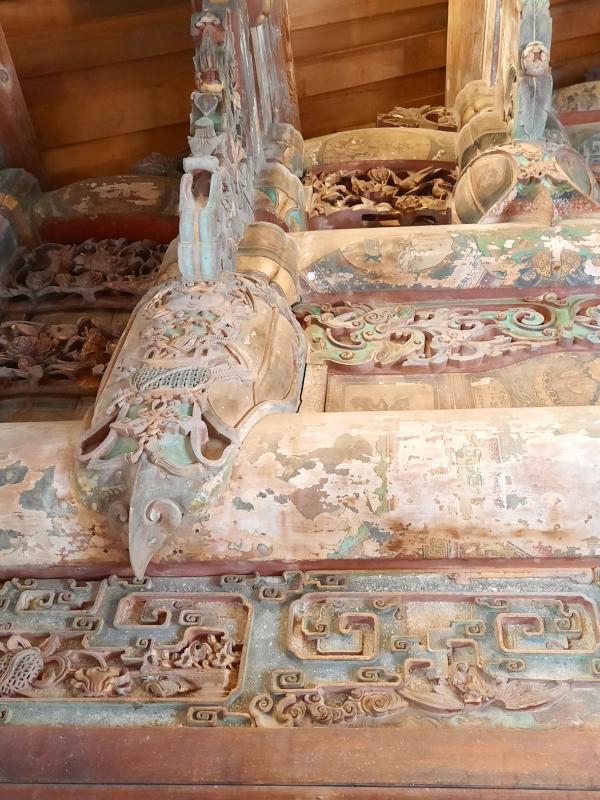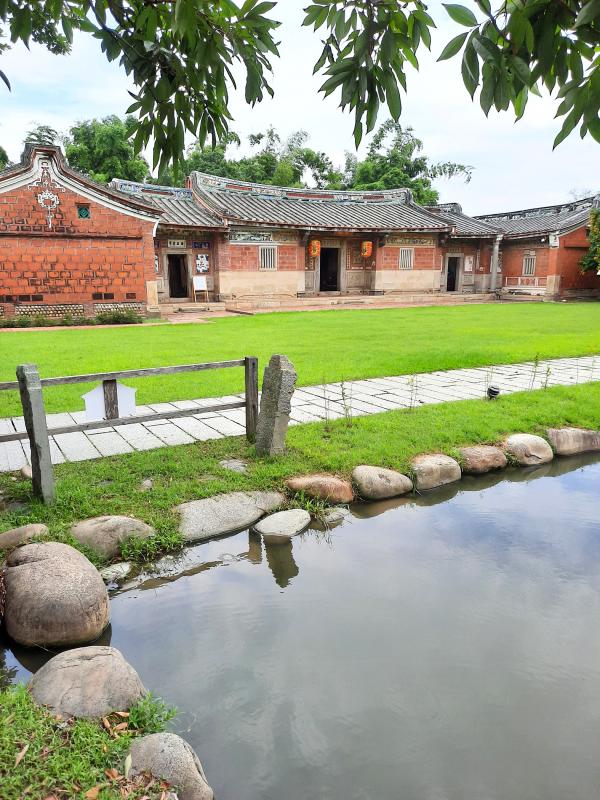Twenty-five sweltering minutes on foot took me past shops that cater to Southeast Asian migrant workers, as well as rows of factories in which they work, to a spot where a townhouse had been demolished.
Through the gap, I could see the corner of a single-story building that obviously predated Taiwan’s industrialization. I’d reached Zhaixing Cottage (摘星山莊) in Taichung City’s Tanzih District (潭子), and it turned out to be more than worth the trek.
According to the Web site I’d looked at before leaving home, the address beside the doorway — 88 Tanfu Road Section 2 (潭富路二段) — was the right one. But the door itself was firmly locked, and it looked as though it hadn’t been opened for quite some time.

Photo: Steven Crook
A notice informed me that the actual entrance is just down the road at number 124. There, I bought a ticket and stepped into a very different world.
FOUR-SIDED RESIDENCE

Photo: Steven Crook
Zhaixing Cottage is an exquisite sight. Within the grounds, which cover 2,440 pings (8,064 square meters), there are longan, lychee, mango and rose apple trees. Dozens of fish inhabit the pond in front of the main building. After tramping through Tanzih’s industrial neighborhoods, the cottage and its setting were a more delightful change of scenery than I’d dared hope for.
Construction of this traditional four-sided residence (siheyuan, 四合院) was commissioned in 1871 by Lin Chi-chung (林其中). A local man and former military officer, Lin had made a name for himself fighting on behalf of the Qing Empire against the Taiping rebels in China. Later, he returned to Taiwan to help organize the suppression of the 1862-1865 uprising led by Tai Chao-chun (戴潮春).
Lin lived in the cottage between its completion in 1879 and his death five years later at the age of 52. In 1997, his descendants sold the land. When it looked likely that the cottage — by then in poor condition — would be leveled so the site could be redeveloped, cultural activists intervened.

Photo: Steven Crook
The local government quickly designated the building as a cultural heritage site in order to preserve it, but several years passed before renovation work could begin. Finally, in May 2010 the doors were opened to the public.
In keeping with the architectural conventions of old China, the original entrance (the one at 88 Tanfu Road Section 2) is on the southeastern edge of the compound, and the ancestral shrine faces due south.
To reach the shrine, I had to pass through a hall with masses of carved wood and a number of painted wall panels. Unlike some other relics in Taiwan which have been “over-restored,” many of the carvings and paintings inside Zhaixing Cottage have been left as they were found. Despite the stains, faded colors and peeling paint, the level of skill and detail is obvious.

Photo: Steven Crook
Two of the most impressive paintings were executed by Kuo You-mei (郭友梅, 1849-1915), a renowned artist based in Lukang. His name can be seen on the upper left side of the panels.
Some of the side chambers are rented out to artisans who make and sell, among other things, tobacco pipes. If you buy a coffee or an ice cream, you can get a NT$50 discount by showing your entrance ticket.
Torn between a desire to linger at this delightful house and a compulsion to do more sightseeing, I eventually left and began walking north on small country roads.

Photo: Steven Crook
Soon I crossed the Tanyashen Green Bikeway (潭雅神綠園道), a 14km-long bicycle trail which connects — and is named for — the three districts of Tanzih, Daya (大雅), and Shengang (神岡). From what I saw of it, it looked to be a well-designed and properly maintained bikeway that’s popular with joggers as well as cyclists.
MISO MUSEUM
My objective was Taiwan Miso Cultural Museum (台灣味噌釀造文化館), just inside Fengyuan District (豐原) at 701 Sishih Road (西勢路701號). Getting there took me about 20 minutes.
The museum occupies part of a factory owned by Wei Jung Food Industry Co, one of Taiwan’s oldest food companies. In English-language materials, the company now brands its products SauceCo rather than Wei Jung (味榮).
The museum has some Chinese-only information about how miso is made, but there’s very little about the history of this traditional soy-based seasoning.
Miso soup became common in Taiwan during the 1895-1945 period of Japanese colonial rule. A Japanese citizen who’s lived in Taiwan for several years has told me that Taiwanese miso is sweeter than its Japanese counterpart.
If you’ve not booked a guided tour, or a DIY session in which you can learn how to make miso, there’s only one reason to go out of your way to Taiwan Miso Cultural Museum: Its shop stocks an intriguing range of gourmet sauces, vinegars and other food items seldom seen in normal supermarkets.
The sun was high, and I knew the walk to the railway station at Lilin (栗林) would be another 20-minute march. I didn’t want to make my daypack any heavier, so all I bought was a small packet of dried pomelo peel.
As I write this, a week later, the packet sits untouched in my pantry. However, the image files from that morning at Zhaixing Cottage have been opened again and again. They’re perfect reminders that not everything humanity does in Taiwan diminishes the island’s tremendous natural beauty.
Steven Crook has been writing about travel, culture and business in Taiwan since 1996. He is the author of Taiwan: The Bradt Travel Guide and co-author of A Culinary History of Taipei: Beyond Pork and Ponlai.

Since their leader Ko Wen-je (柯文哲) and others were jailed as part of several ongoing bribery investigations, the Taiwan People’s Party (TPP) has risen in the polls. Additionally, despite all the many and varied allegations against Ko and most of the top people in the party, it has held together with only a tiny number of minor figures exiting. The TPP has taken some damage, but vastly less than the New Power Party (NPP) did after it was caught up in a bribery scandal in 2020. The TPP has for years registered favorability in the thirties, and a Formosa poll

Chiayi County is blessed with several worthwhile upland trails, not all of which I’ve hiked. A few weeks ago, I finally got around to tackling Tanghu Historic Trail (塘湖古道), a short but unusually steep route in Jhuci Township (竹崎). According to the Web site of the Alishan National Scenic Area (阿里山國家風景區), the path climbs from 308m above sea level to an elevation of 770m in just 1.58km, an average gradient of 29 percent. And unless you arrange for someone to bring you to the starting point and collect you at the other end, there’s no way to avoid a significant amount

Nov. 4 to Nov. 10 Apollo magazine (文星) vowed that it wouldn’t play by the rules in its first issue — a bold statement to make in 1957, when anyone could be jailed for saying the wrong thing. However, the introduction to the inaugural Nov. 5 issue also defined the magazine as a “lifestyle, literature and art” publication, and the contents were relatively tame for the first four years, writes Tao Heng-sheng (陶恒生) in “The Apollo magazine that wouldn’t play by the rules” (不按牌理出牌的文星雜誌). In 1961, the magazine changed its mission to “thought, lifestyle and art” and adopted a more critical tone with

While global attention is finally being focused on the People’s Republic of China (PRC) gray zone aggression against Philippine territory in the South China Sea, at the other end of the PRC’s infamous 9 dash line map, PRC vessels are conducting an identical campaign against Indonesia, most importantly in the Natuna Islands. The Natunas fall into a gray area: do the dashes at the end of the PRC “cow’s tongue” map include the islands? It’s not clear. Less well known is that they also fall into another gray area. Indonesia’s Exclusive Economic Zone (EEZ) claim and continental shelf claim are not